Information Systems Analysis: UNICEF Child Care System Development
VerifiedAdded on 2023/06/13
|13
|2564
|81
Report
AI Summary
This report details a proposed new information system for UNICEF Child Care, addressing inefficiencies in their current manual processes. It advocates for an Agile methodology for system development, outlining functional requirements like login/registration, authentication, online payment processing, and inventory management, as well as non-functional requirements such as cost reduction and user-friendly interface. A cost-benefit analysis demonstrates the project's economic feasibility with a positive net present value and a payback period of 1.55 years. The report includes a project schedule with a work breakdown structure and Gantt chart, and it identifies key stakeholders and investigation techniques like interviewing, surveys, and document reviews for gathering system information requirements. The project aims to automate payment processing and supply ordering, ultimately improving UNICEF Child Care's operational efficiency. Desklib provides access to this and other solved assignments.
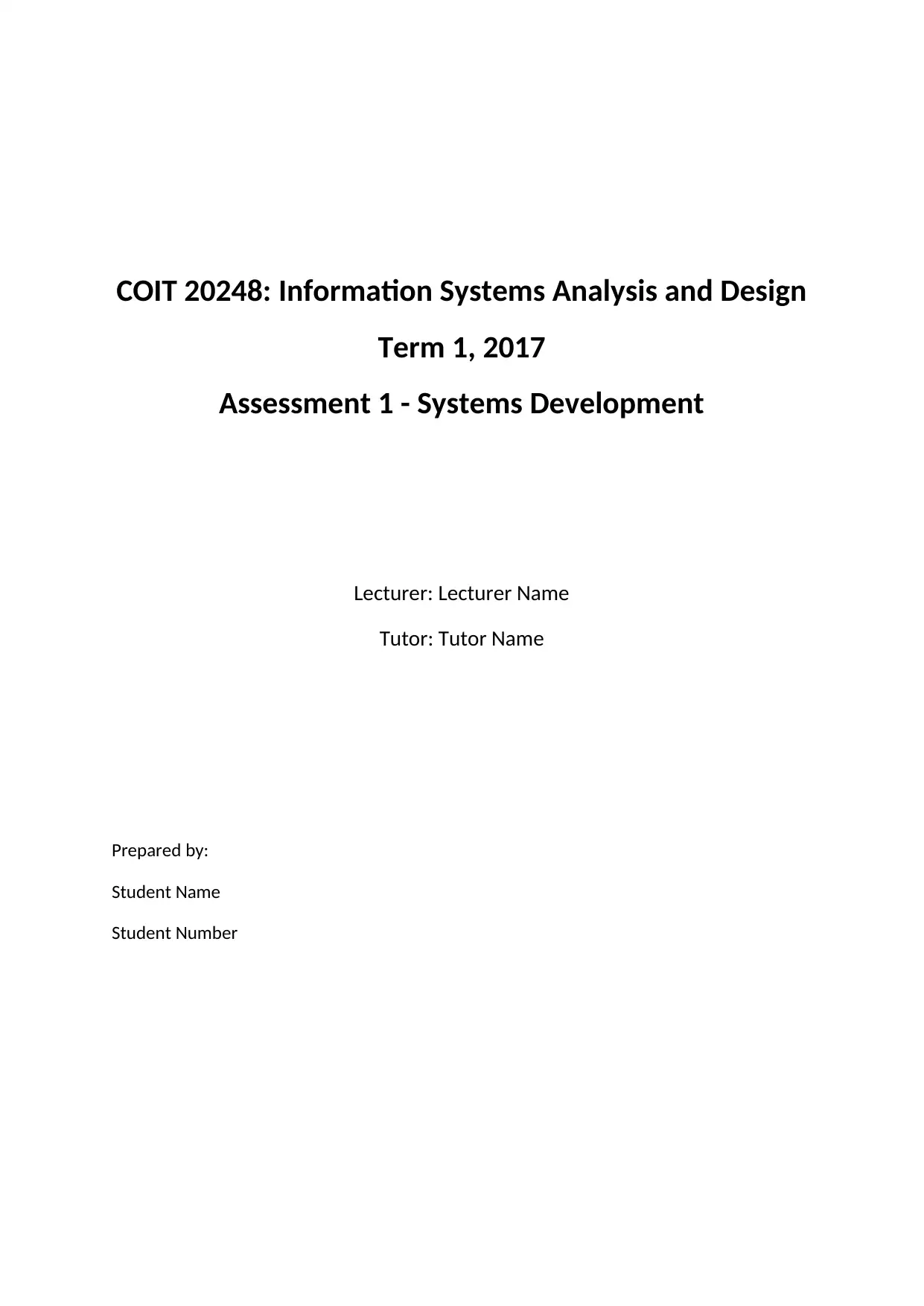
COIT 20248: Information Systems Analysis and Design
Term 1, 2017
Assessment 1 - Systems Development
Lecturer: Lecturer Name
Tutor: Tutor Name
Prepared by:
Student Name
Student Number
Term 1, 2017
Assessment 1 - Systems Development
Lecturer: Lecturer Name
Tutor: Tutor Name
Prepared by:
Student Name
Student Number
Paraphrase This Document
Need a fresh take? Get an instant paraphrase of this document with our AI Paraphraser
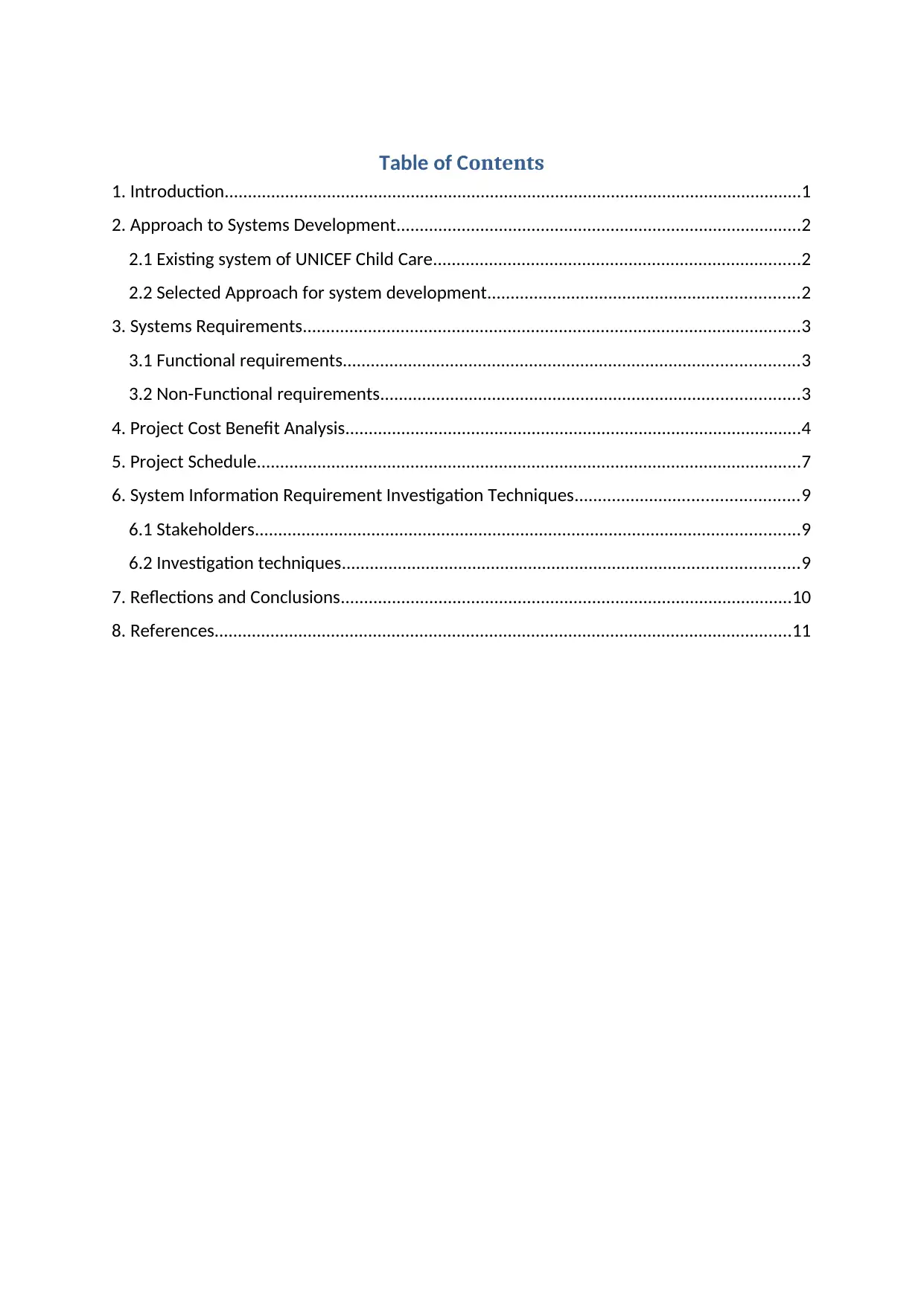
Table of Contents
1. Introduction............................................................................................................................1
2. Approach to Systems Development.......................................................................................2
2.1 Existing system of UNICEF Child Care...............................................................................2
2.2 Selected Approach for system development...................................................................2
3. Systems Requirements...........................................................................................................3
3.1 Functional requirements..................................................................................................3
3.2 Non-Functional requirements..........................................................................................3
4. Project Cost Benefit Analysis..................................................................................................4
5. Project Schedule.....................................................................................................................7
6. System Information Requirement Investigation Techniques................................................9
6.1 Stakeholders.....................................................................................................................9
6.2 Investigation techniques..................................................................................................9
7. Reflections and Conclusions.................................................................................................10
8. References............................................................................................................................11
1. Introduction............................................................................................................................1
2. Approach to Systems Development.......................................................................................2
2.1 Existing system of UNICEF Child Care...............................................................................2
2.2 Selected Approach for system development...................................................................2
3. Systems Requirements...........................................................................................................3
3.1 Functional requirements..................................................................................................3
3.2 Non-Functional requirements..........................................................................................3
4. Project Cost Benefit Analysis..................................................................................................4
5. Project Schedule.....................................................................................................................7
6. System Information Requirement Investigation Techniques................................................9
6.1 Stakeholders.....................................................................................................................9
6.2 Investigation techniques..................................................................................................9
7. Reflections and Conclusions.................................................................................................10
8. References............................................................................................................................11
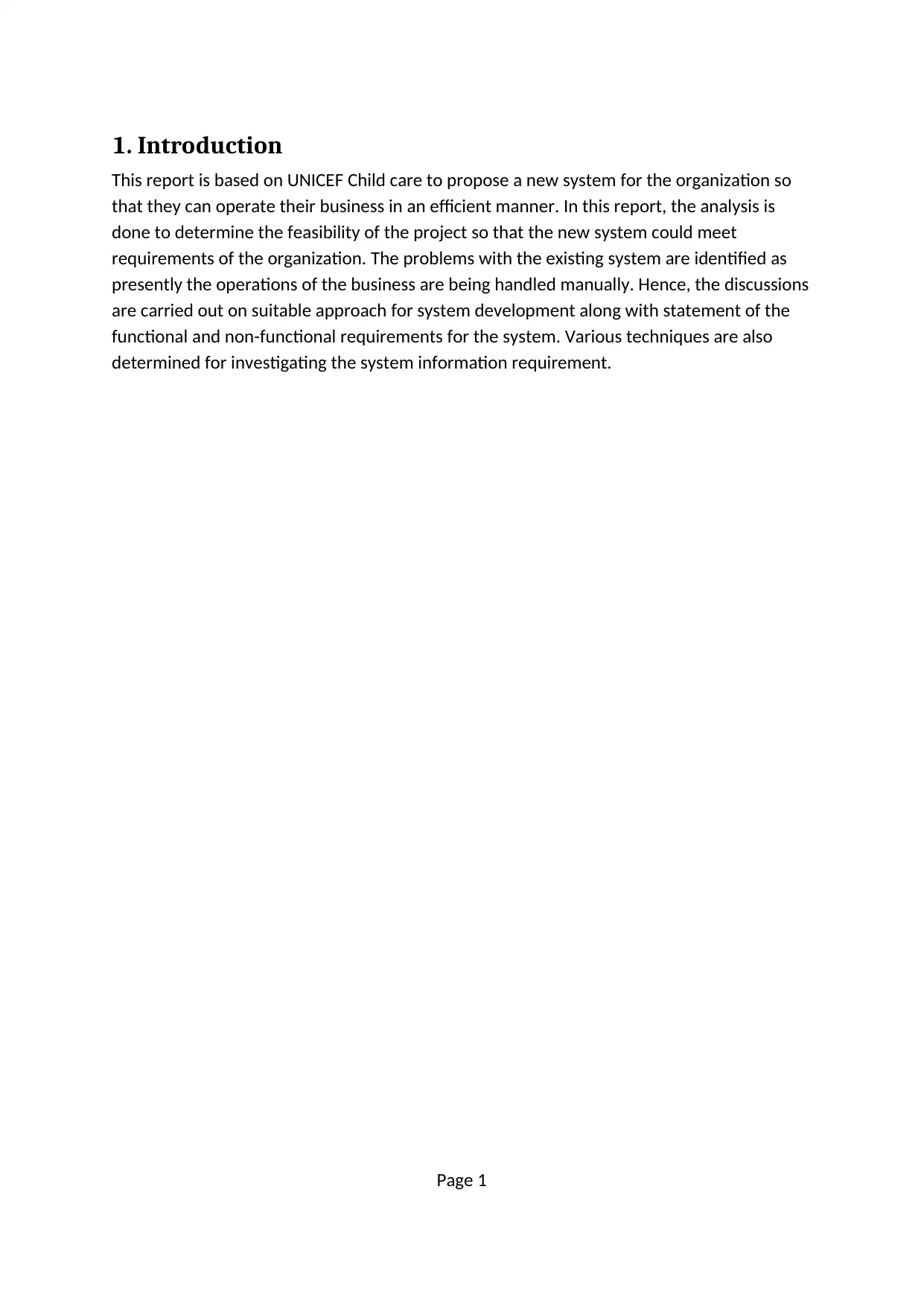
1. Introduction
This report is based on UNICEF Child care to propose a new system for the organization so
that they can operate their business in an efficient manner. In this report, the analysis is
done to determine the feasibility of the project so that the new system could meet
requirements of the organization. The problems with the existing system are identified as
presently the operations of the business are being handled manually. Hence, the discussions
are carried out on suitable approach for system development along with statement of the
functional and non-functional requirements for the system. Various techniques are also
determined for investigating the system information requirement.
Page 1
This report is based on UNICEF Child care to propose a new system for the organization so
that they can operate their business in an efficient manner. In this report, the analysis is
done to determine the feasibility of the project so that the new system could meet
requirements of the organization. The problems with the existing system are identified as
presently the operations of the business are being handled manually. Hence, the discussions
are carried out on suitable approach for system development along with statement of the
functional and non-functional requirements for the system. Various techniques are also
determined for investigating the system information requirement.
Page 1
⊘ This is a preview!⊘
Do you want full access?
Subscribe today to unlock all pages.

Trusted by 1+ million students worldwide
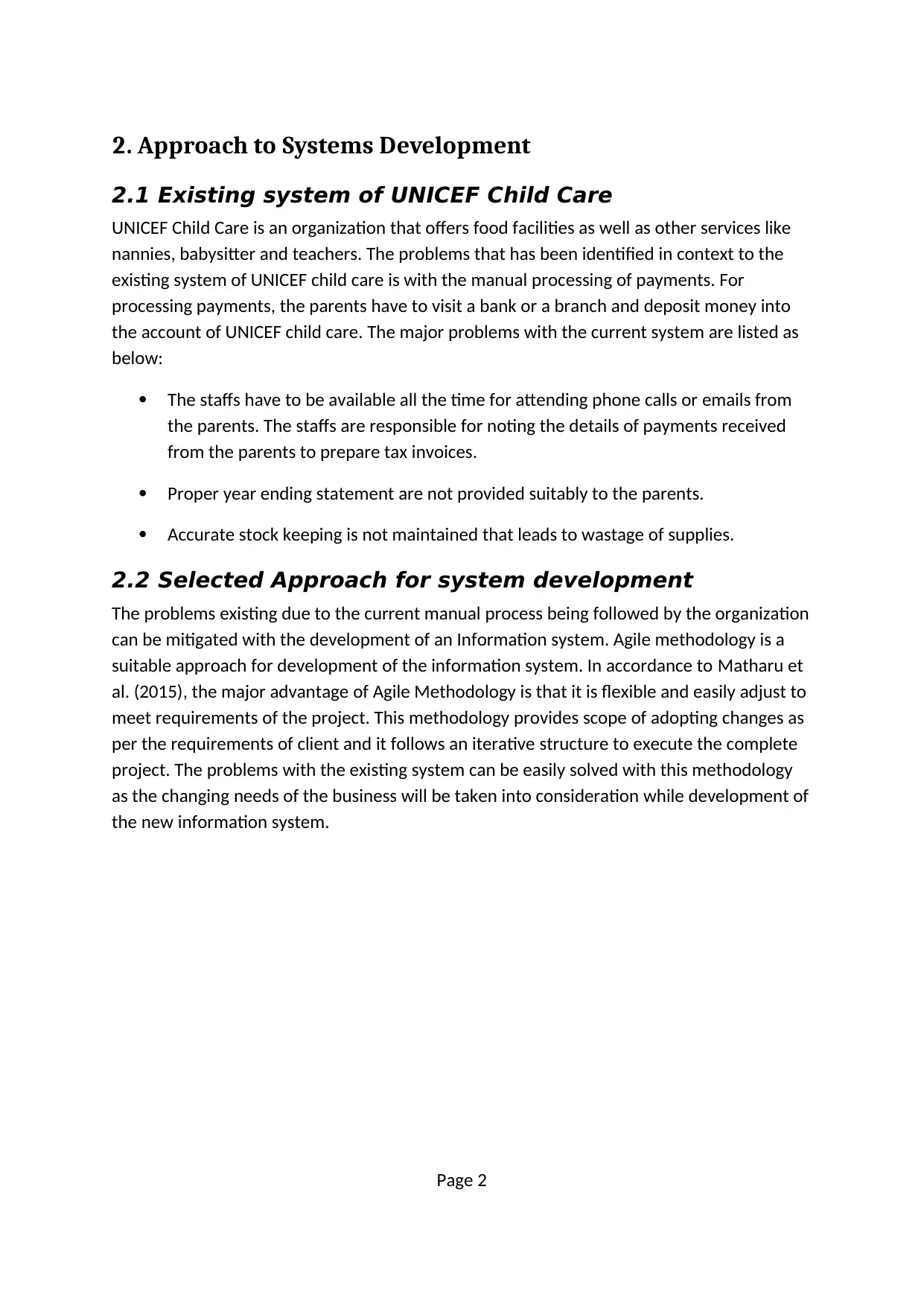
2. Approach to Systems Development
2.1 Existing system of UNICEF Child Care
UNICEF Child Care is an organization that offers food facilities as well as other services like
nannies, babysitter and teachers. The problems that has been identified in context to the
existing system of UNICEF child care is with the manual processing of payments. For
processing payments, the parents have to visit a bank or a branch and deposit money into
the account of UNICEF child care. The major problems with the current system are listed as
below:
The staffs have to be available all the time for attending phone calls or emails from
the parents. The staffs are responsible for noting the details of payments received
from the parents to prepare tax invoices.
Proper year ending statement are not provided suitably to the parents.
Accurate stock keeping is not maintained that leads to wastage of supplies.
2.2 Selected Approach for system development
The problems existing due to the current manual process being followed by the organization
can be mitigated with the development of an Information system. Agile methodology is a
suitable approach for development of the information system. In accordance to Matharu et
al. (2015), the major advantage of Agile Methodology is that it is flexible and easily adjust to
meet requirements of the project. This methodology provides scope of adopting changes as
per the requirements of client and it follows an iterative structure to execute the complete
project. The problems with the existing system can be easily solved with this methodology
as the changing needs of the business will be taken into consideration while development of
the new information system.
Page 2
2.1 Existing system of UNICEF Child Care
UNICEF Child Care is an organization that offers food facilities as well as other services like
nannies, babysitter and teachers. The problems that has been identified in context to the
existing system of UNICEF child care is with the manual processing of payments. For
processing payments, the parents have to visit a bank or a branch and deposit money into
the account of UNICEF child care. The major problems with the current system are listed as
below:
The staffs have to be available all the time for attending phone calls or emails from
the parents. The staffs are responsible for noting the details of payments received
from the parents to prepare tax invoices.
Proper year ending statement are not provided suitably to the parents.
Accurate stock keeping is not maintained that leads to wastage of supplies.
2.2 Selected Approach for system development
The problems existing due to the current manual process being followed by the organization
can be mitigated with the development of an Information system. Agile methodology is a
suitable approach for development of the information system. In accordance to Matharu et
al. (2015), the major advantage of Agile Methodology is that it is flexible and easily adjust to
meet requirements of the project. This methodology provides scope of adopting changes as
per the requirements of client and it follows an iterative structure to execute the complete
project. The problems with the existing system can be easily solved with this methodology
as the changing needs of the business will be taken into consideration while development of
the new information system.
Page 2
Paraphrase This Document
Need a fresh take? Get an instant paraphrase of this document with our AI Paraphraser
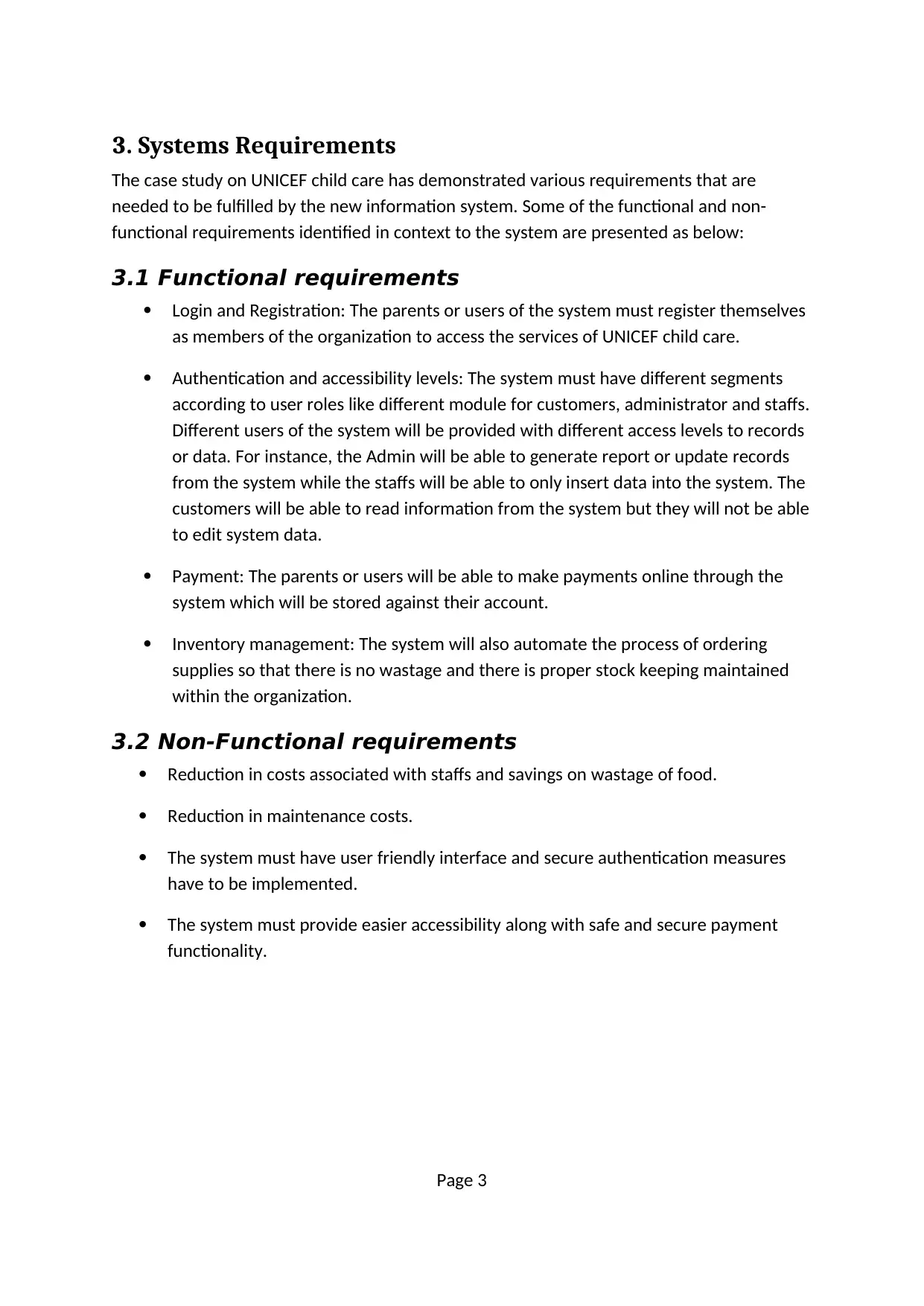
3. Systems Requirements
The case study on UNICEF child care has demonstrated various requirements that are
needed to be fulfilled by the new information system. Some of the functional and non-
functional requirements identified in context to the system are presented as below:
3.1 Functional requirements
Login and Registration: The parents or users of the system must register themselves
as members of the organization to access the services of UNICEF child care.
Authentication and accessibility levels: The system must have different segments
according to user roles like different module for customers, administrator and staffs.
Different users of the system will be provided with different access levels to records
or data. For instance, the Admin will be able to generate report or update records
from the system while the staffs will be able to only insert data into the system. The
customers will be able to read information from the system but they will not be able
to edit system data.
Payment: The parents or users will be able to make payments online through the
system which will be stored against their account.
Inventory management: The system will also automate the process of ordering
supplies so that there is no wastage and there is proper stock keeping maintained
within the organization.
3.2 Non-Functional requirements
Reduction in costs associated with staffs and savings on wastage of food.
Reduction in maintenance costs.
The system must have user friendly interface and secure authentication measures
have to be implemented.
The system must provide easier accessibility along with safe and secure payment
functionality.
Page 3
The case study on UNICEF child care has demonstrated various requirements that are
needed to be fulfilled by the new information system. Some of the functional and non-
functional requirements identified in context to the system are presented as below:
3.1 Functional requirements
Login and Registration: The parents or users of the system must register themselves
as members of the organization to access the services of UNICEF child care.
Authentication and accessibility levels: The system must have different segments
according to user roles like different module for customers, administrator and staffs.
Different users of the system will be provided with different access levels to records
or data. For instance, the Admin will be able to generate report or update records
from the system while the staffs will be able to only insert data into the system. The
customers will be able to read information from the system but they will not be able
to edit system data.
Payment: The parents or users will be able to make payments online through the
system which will be stored against their account.
Inventory management: The system will also automate the process of ordering
supplies so that there is no wastage and there is proper stock keeping maintained
within the organization.
3.2 Non-Functional requirements
Reduction in costs associated with staffs and savings on wastage of food.
Reduction in maintenance costs.
The system must have user friendly interface and secure authentication measures
have to be implemented.
The system must provide easier accessibility along with safe and secure payment
functionality.
Page 3
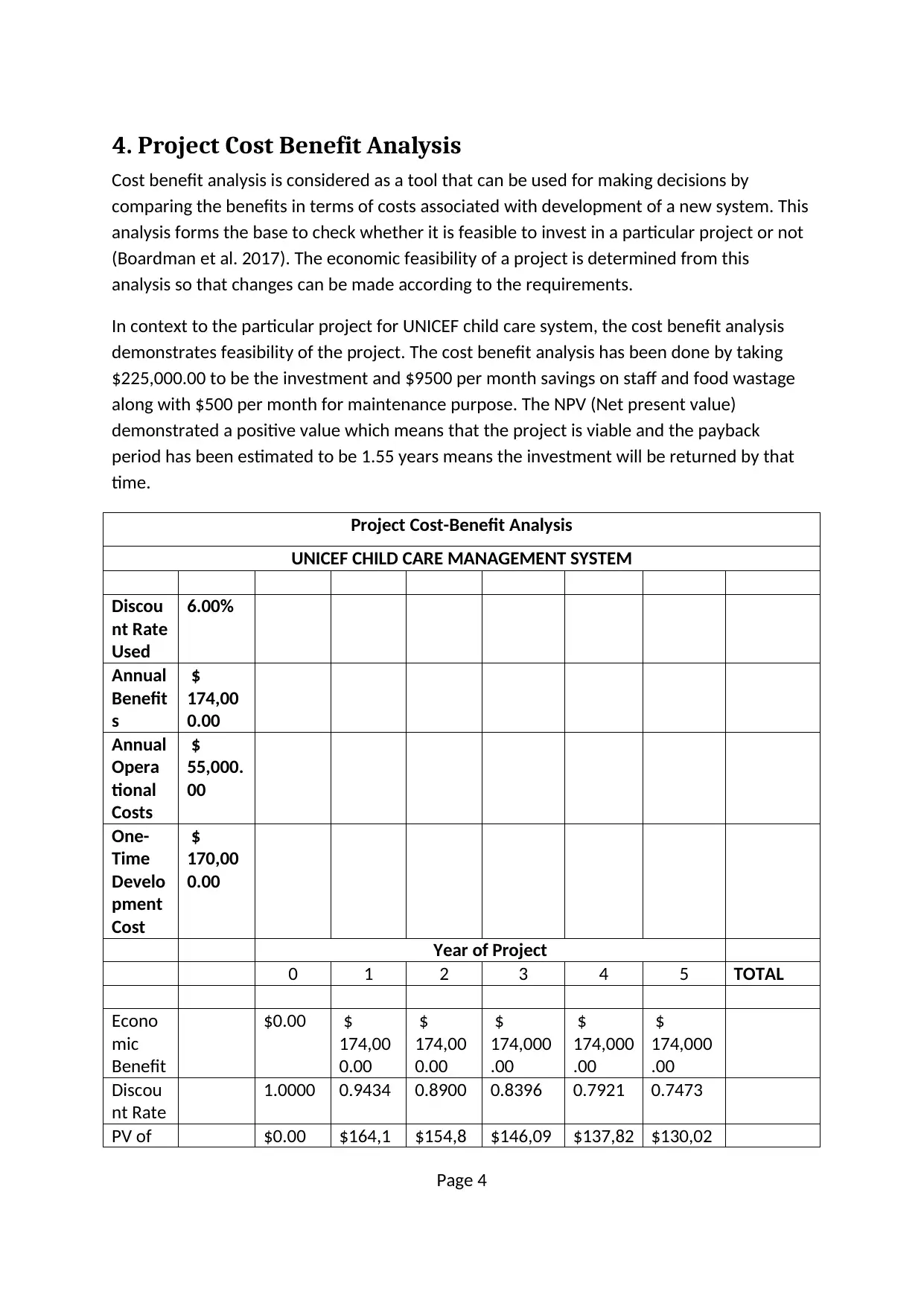
4. Project Cost Benefit Analysis
Cost benefit analysis is considered as a tool that can be used for making decisions by
comparing the benefits in terms of costs associated with development of a new system. This
analysis forms the base to check whether it is feasible to invest in a particular project or not
(Boardman et al. 2017). The economic feasibility of a project is determined from this
analysis so that changes can be made according to the requirements.
In context to the particular project for UNICEF child care system, the cost benefit analysis
demonstrates feasibility of the project. The cost benefit analysis has been done by taking
$225,000.00 to be the investment and $9500 per month savings on staff and food wastage
along with $500 per month for maintenance purpose. The NPV (Net present value)
demonstrated a positive value which means that the project is viable and the payback
period has been estimated to be 1.55 years means the investment will be returned by that
time.
Project Cost-Benefit Analysis
UNICEF CHILD CARE MANAGEMENT SYSTEM
Discou
nt Rate
Used
6.00%
Annual
Benefit
s
$
174,00
0.00
Annual
Opera
tional
Costs
$
55,000.
00
One-
Time
Develo
pment
Cost
$
170,00
0.00
Year of Project
0 1 2 3 4 5 TOTAL
Econo
mic
Benefit
$0.00 $
174,00
0.00
$
174,00
0.00
$
174,000
.00
$
174,000
.00
$
174,000
.00
Discou
nt Rate
1.0000 0.9434 0.8900 0.8396 0.7921 0.7473
PV of $0.00 $164,1 $154,8 $146,09 $137,82 $130,02
Page 4
Cost benefit analysis is considered as a tool that can be used for making decisions by
comparing the benefits in terms of costs associated with development of a new system. This
analysis forms the base to check whether it is feasible to invest in a particular project or not
(Boardman et al. 2017). The economic feasibility of a project is determined from this
analysis so that changes can be made according to the requirements.
In context to the particular project for UNICEF child care system, the cost benefit analysis
demonstrates feasibility of the project. The cost benefit analysis has been done by taking
$225,000.00 to be the investment and $9500 per month savings on staff and food wastage
along with $500 per month for maintenance purpose. The NPV (Net present value)
demonstrated a positive value which means that the project is viable and the payback
period has been estimated to be 1.55 years means the investment will be returned by that
time.
Project Cost-Benefit Analysis
UNICEF CHILD CARE MANAGEMENT SYSTEM
Discou
nt Rate
Used
6.00%
Annual
Benefit
s
$
174,00
0.00
Annual
Opera
tional
Costs
$
55,000.
00
One-
Time
Develo
pment
Cost
$
170,00
0.00
Year of Project
0 1 2 3 4 5 TOTAL
Econo
mic
Benefit
$0.00 $
174,00
0.00
$
174,00
0.00
$
174,000
.00
$
174,000
.00
$
174,000
.00
Discou
nt Rate
1.0000 0.9434 0.8900 0.8396 0.7921 0.7473
PV of $0.00 $164,1 $154,8 $146,09 $137,82 $130,02
Page 4
⊘ This is a preview!⊘
Do you want full access?
Subscribe today to unlock all pages.

Trusted by 1+ million students worldwide
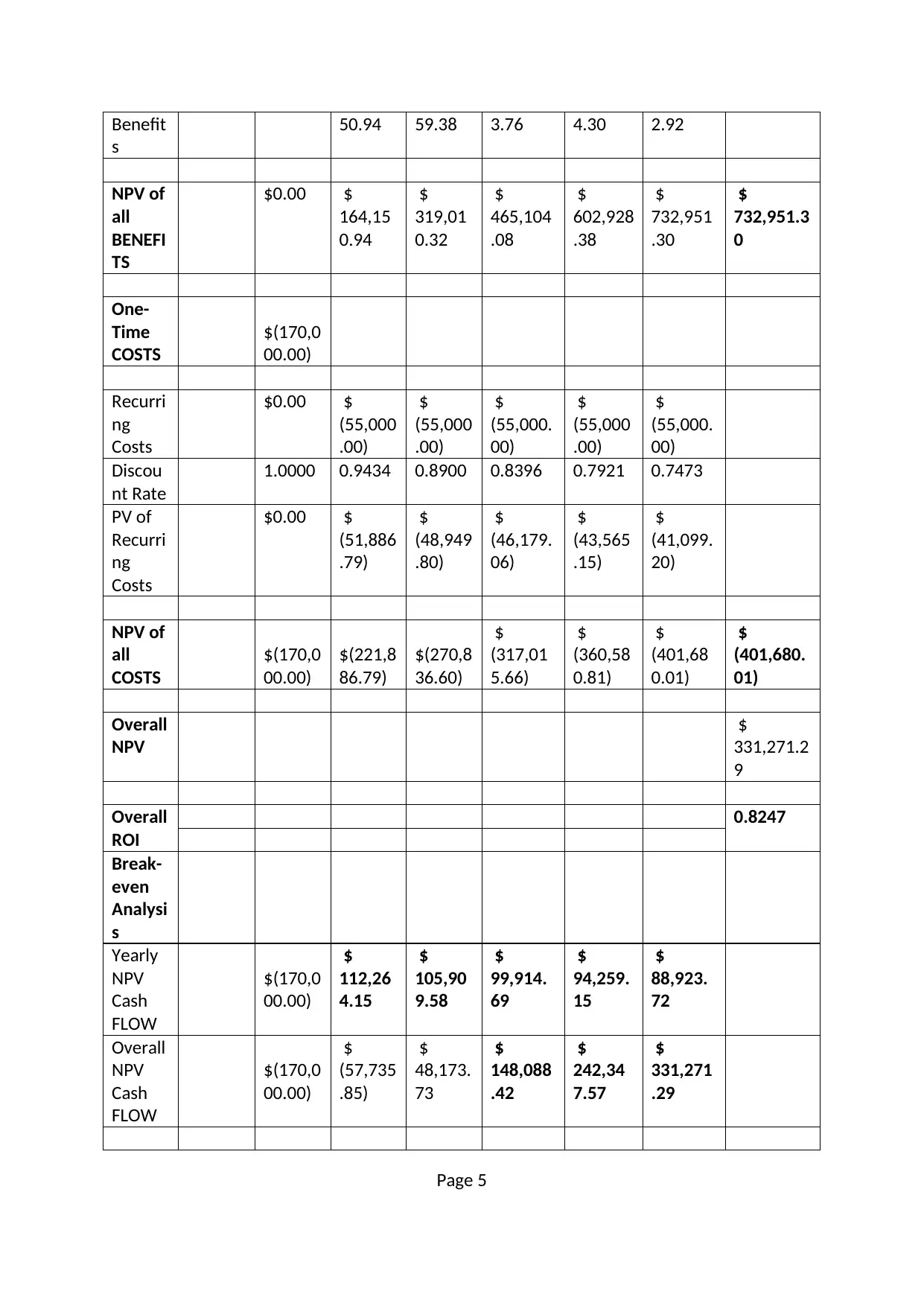
Benefit
s
50.94 59.38 3.76 4.30 2.92
NPV of
all
BENEFI
TS
$0.00 $
164,15
0.94
$
319,01
0.32
$
465,104
.08
$
602,928
.38
$
732,951
.30
$
732,951.3
0
One-
Time
COSTS
$(170,0
00.00)
Recurri
ng
Costs
$0.00 $
(55,000
.00)
$
(55,000
.00)
$
(55,000.
00)
$
(55,000
.00)
$
(55,000.
00)
Discou
nt Rate
1.0000 0.9434 0.8900 0.8396 0.7921 0.7473
PV of
Recurri
ng
Costs
$0.00 $
(51,886
.79)
$
(48,949
.80)
$
(46,179.
06)
$
(43,565
.15)
$
(41,099.
20)
NPV of
all
COSTS
$(170,0
00.00)
$(221,8
86.79)
$(270,8
36.60)
$
(317,01
5.66)
$
(360,58
0.81)
$
(401,68
0.01)
$
(401,680.
01)
Overall
NPV
$
331,271.2
9
Overall
ROI
0.8247
Break-
even
Analysi
s
Yearly
NPV
Cash
FLOW
$(170,0
00.00)
$
112,26
4.15
$
105,90
9.58
$
99,914.
69
$
94,259.
15
$
88,923.
72
Overall
NPV
Cash
FLOW
$(170,0
00.00)
$
(57,735
.85)
$
48,173.
73
$
148,088
.42
$
242,34
7.57
$
331,271
.29
Page 5
s
50.94 59.38 3.76 4.30 2.92
NPV of
all
BENEFI
TS
$0.00 $
164,15
0.94
$
319,01
0.32
$
465,104
.08
$
602,928
.38
$
732,951
.30
$
732,951.3
0
One-
Time
COSTS
$(170,0
00.00)
Recurri
ng
Costs
$0.00 $
(55,000
.00)
$
(55,000
.00)
$
(55,000.
00)
$
(55,000
.00)
$
(55,000.
00)
Discou
nt Rate
1.0000 0.9434 0.8900 0.8396 0.7921 0.7473
PV of
Recurri
ng
Costs
$0.00 $
(51,886
.79)
$
(48,949
.80)
$
(46,179.
06)
$
(43,565
.15)
$
(41,099.
20)
NPV of
all
COSTS
$(170,0
00.00)
$(221,8
86.79)
$(270,8
36.60)
$
(317,01
5.66)
$
(360,58
0.81)
$
(401,68
0.01)
$
(401,680.
01)
Overall
NPV
$
331,271.2
9
Overall
ROI
0.8247
Break-
even
Analysi
s
Yearly
NPV
Cash
FLOW
$(170,0
00.00)
$
112,26
4.15
$
105,90
9.58
$
99,914.
69
$
94,259.
15
$
88,923.
72
Overall
NPV
Cash
FLOW
$(170,0
00.00)
$
(57,735
.85)
$
48,173.
73
$
148,088
.42
$
242,34
7.57
$
331,271
.29
Page 5
Paraphrase This Document
Need a fresh take? Get an instant paraphrase of this document with our AI Paraphraser
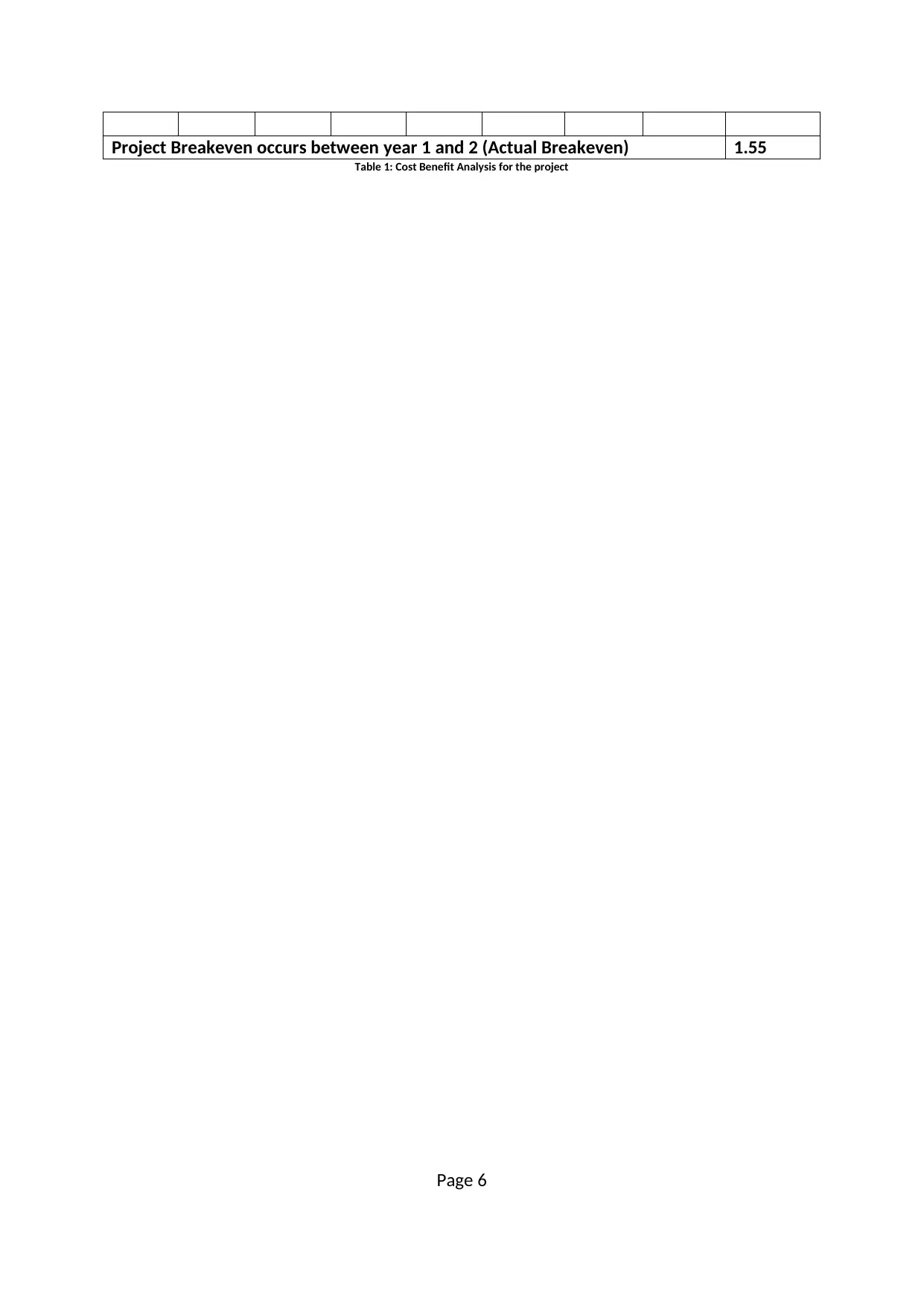
Project Breakeven occurs between year 1 and 2 (Actual Breakeven) 1.55
Table 1: Cost Benefit Analysis for the project
Page 6
Table 1: Cost Benefit Analysis for the project
Page 6
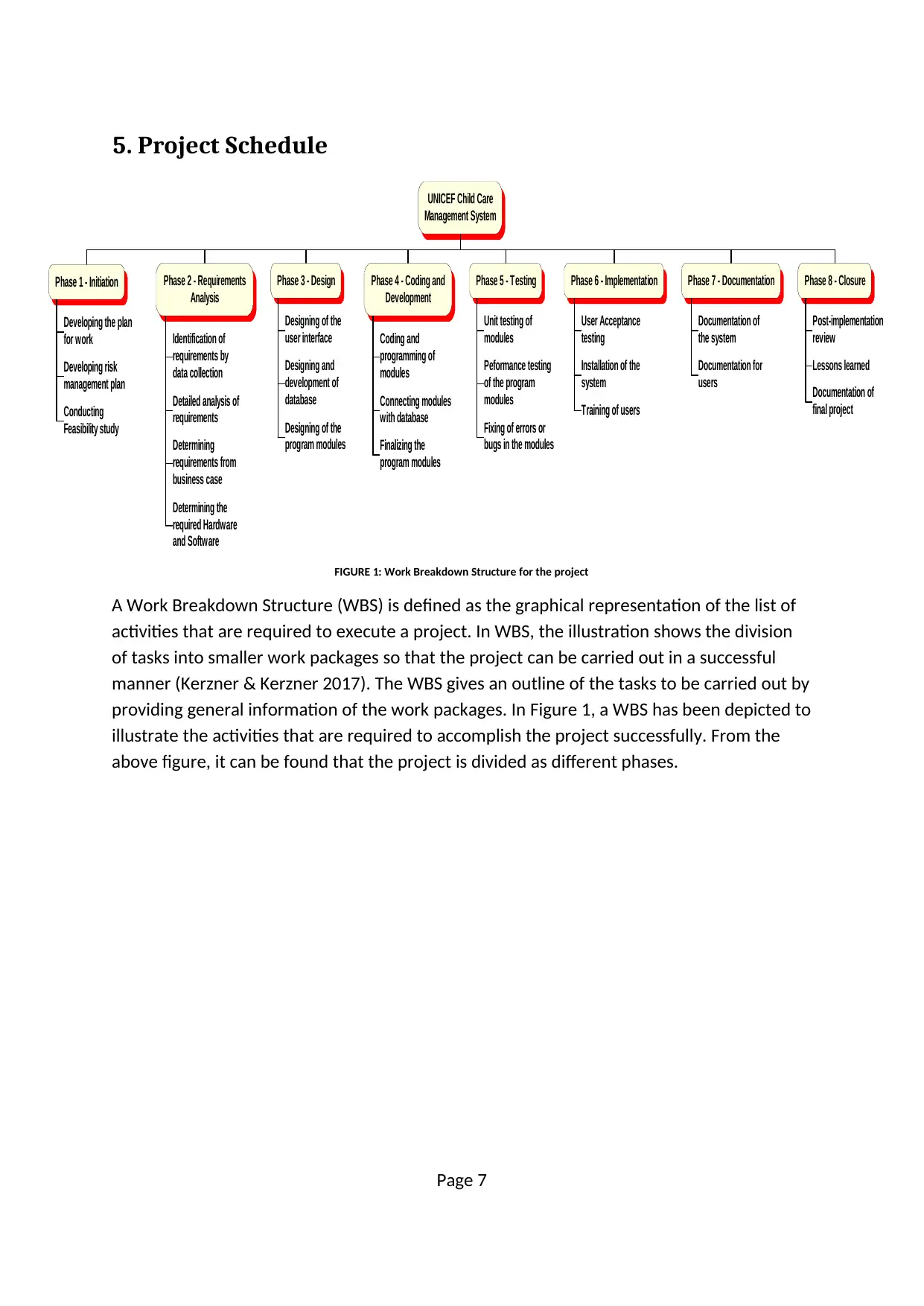
5. Project Schedule
UNICEF Child Care
Management System
Phase 1 - Initiation
Developing the plan
for work
Developing risk
management plan
Conducting
Feasibility study
Phase 2 - Requirements
Analysis
Identification of
requirements by
data collection
Detailed analysis of
requirements
Determining
requirements from
business case
Determining the
required Hardware
and Software
Phase 3 - Design
Designing of the
user interface
Designing and
development of
database
Designing of the
program modules
Phase 4 - Coding and
Development
Coding and
programming of
modules
Connecting modules
with database
Finalizing the
program modules
Phase 5 - Testing
Unit testing of
modules
Peformance testing
of the program
modules
Fixing of errors or
bugs in the modules
Phase 6 - Implementation
User Acceptance
testing
Installation of the
system
Training of users
Phase 7 - Documentation
Documentation of
the system
Documentation for
users
Phase 8 - Closure
Post-implementation
review
Lessons learned
Documentation of
final project
FIGURE 1: Work Breakdown Structure for the project
A Work Breakdown Structure (WBS) is defined as the graphical representation of the list of
activities that are required to execute a project. In WBS, the illustration shows the division
of tasks into smaller work packages so that the project can be carried out in a successful
manner (Kerzner & Kerzner 2017). The WBS gives an outline of the tasks to be carried out by
providing general information of the work packages. In Figure 1, a WBS has been depicted to
illustrate the activities that are required to accomplish the project successfully. From the
above figure, it can be found that the project is divided as different phases.
Page 7
UNICEF Child Care
Management System
Phase 1 - Initiation
Developing the plan
for work
Developing risk
management plan
Conducting
Feasibility study
Phase 2 - Requirements
Analysis
Identification of
requirements by
data collection
Detailed analysis of
requirements
Determining
requirements from
business case
Determining the
required Hardware
and Software
Phase 3 - Design
Designing of the
user interface
Designing and
development of
database
Designing of the
program modules
Phase 4 - Coding and
Development
Coding and
programming of
modules
Connecting modules
with database
Finalizing the
program modules
Phase 5 - Testing
Unit testing of
modules
Peformance testing
of the program
modules
Fixing of errors or
bugs in the modules
Phase 6 - Implementation
User Acceptance
testing
Installation of the
system
Training of users
Phase 7 - Documentation
Documentation of
the system
Documentation for
users
Phase 8 - Closure
Post-implementation
review
Lessons learned
Documentation of
final project
FIGURE 1: Work Breakdown Structure for the project
A Work Breakdown Structure (WBS) is defined as the graphical representation of the list of
activities that are required to execute a project. In WBS, the illustration shows the division
of tasks into smaller work packages so that the project can be carried out in a successful
manner (Kerzner & Kerzner 2017). The WBS gives an outline of the tasks to be carried out by
providing general information of the work packages. In Figure 1, a WBS has been depicted to
illustrate the activities that are required to accomplish the project successfully. From the
above figure, it can be found that the project is divided as different phases.
Page 7
⊘ This is a preview!⊘
Do you want full access?
Subscribe today to unlock all pages.

Trusted by 1+ million students worldwide
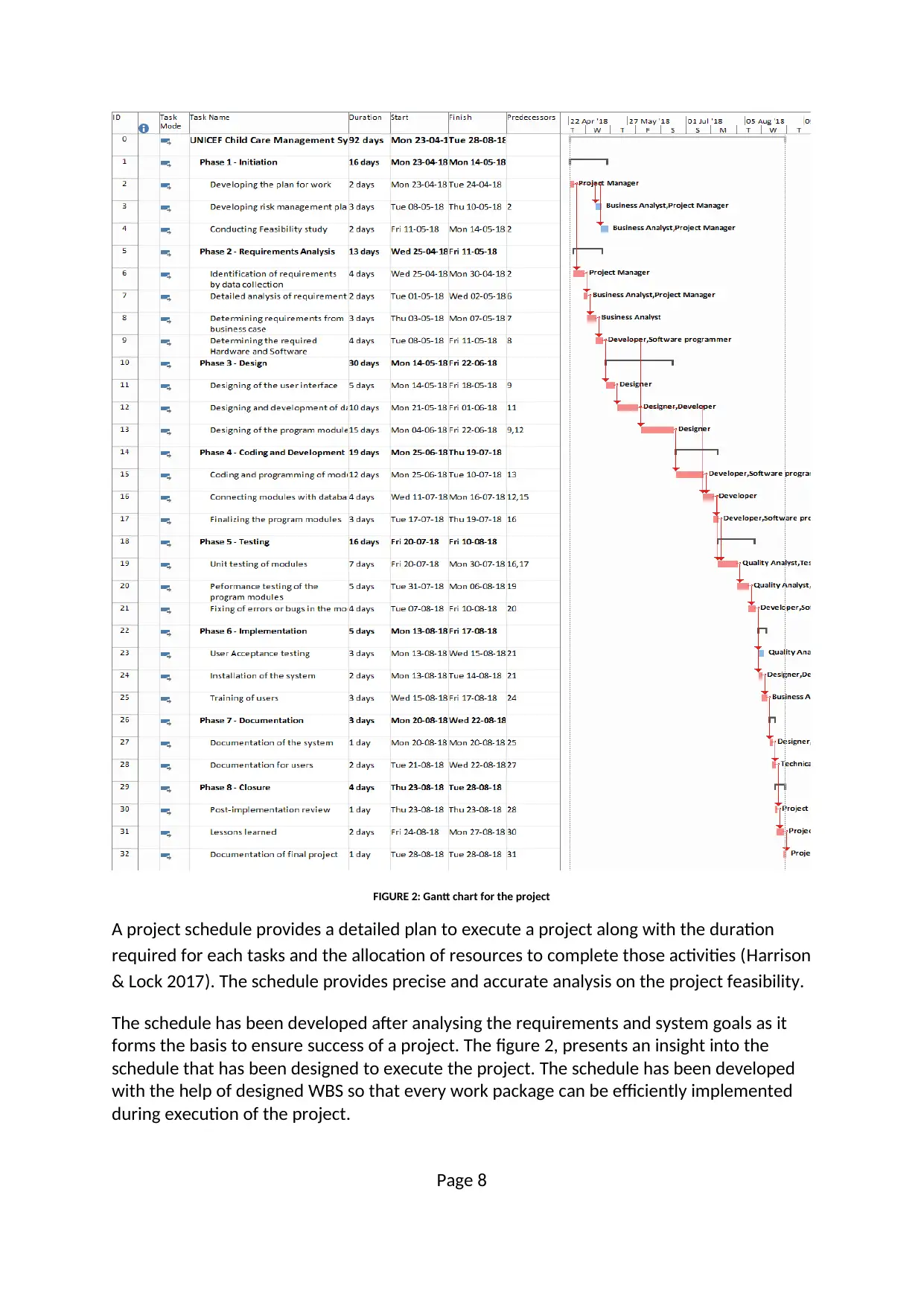
FIGURE 2: Gantt chart for the project
A project schedule provides a detailed plan to execute a project along with the duration
required for each tasks and the allocation of resources to complete those activities (Harrison
& Lock 2017). The schedule provides precise and accurate analysis on the project feasibility.
The schedule has been developed after analysing the requirements and system goals as it
forms the basis to ensure success of a project. The figure 2, presents an insight into the
schedule that has been designed to execute the project. The schedule has been developed
with the help of designed WBS so that every work package can be efficiently implemented
during execution of the project.
Page 8
A project schedule provides a detailed plan to execute a project along with the duration
required for each tasks and the allocation of resources to complete those activities (Harrison
& Lock 2017). The schedule provides precise and accurate analysis on the project feasibility.
The schedule has been developed after analysing the requirements and system goals as it
forms the basis to ensure success of a project. The figure 2, presents an insight into the
schedule that has been designed to execute the project. The schedule has been developed
with the help of designed WBS so that every work package can be efficiently implemented
during execution of the project.
Page 8
Paraphrase This Document
Need a fresh take? Get an instant paraphrase of this document with our AI Paraphraser
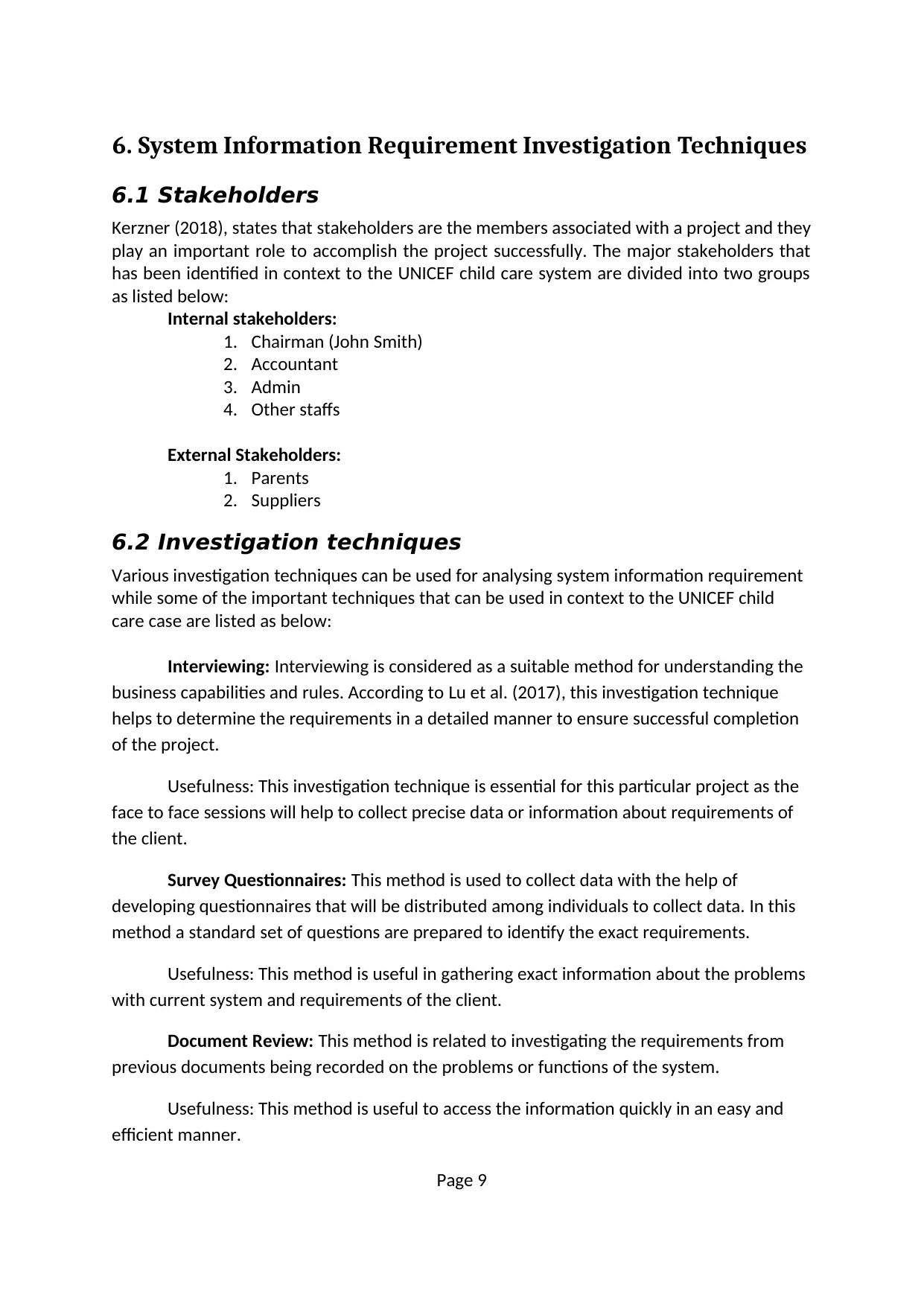
6. System Information Requirement Investigation Techniques
6.1 Stakeholders
Kerzner (2018), states that stakeholders are the members associated with a project and they
play an important role to accomplish the project successfully. The major stakeholders that
has been identified in context to the UNICEF child care system are divided into two groups
as listed below:
Internal stakeholders:
1. Chairman (John Smith)
2. Accountant
3. Admin
4. Other staffs
External Stakeholders:
1. Parents
2. Suppliers
6.2 Investigation techniques
Various investigation techniques can be used for analysing system information requirement
while some of the important techniques that can be used in context to the UNICEF child
care case are listed as below:
Interviewing: Interviewing is considered as a suitable method for understanding the
business capabilities and rules. According to Lu et al. (2017), this investigation technique
helps to determine the requirements in a detailed manner to ensure successful completion
of the project.
Usefulness: This investigation technique is essential for this particular project as the
face to face sessions will help to collect precise data or information about requirements of
the client.
Survey Questionnaires: This method is used to collect data with the help of
developing questionnaires that will be distributed among individuals to collect data. In this
method a standard set of questions are prepared to identify the exact requirements.
Usefulness: This method is useful in gathering exact information about the problems
with current system and requirements of the client.
Document Review: This method is related to investigating the requirements from
previous documents being recorded on the problems or functions of the system.
Usefulness: This method is useful to access the information quickly in an easy and
efficient manner.
Page 9
6.1 Stakeholders
Kerzner (2018), states that stakeholders are the members associated with a project and they
play an important role to accomplish the project successfully. The major stakeholders that
has been identified in context to the UNICEF child care system are divided into two groups
as listed below:
Internal stakeholders:
1. Chairman (John Smith)
2. Accountant
3. Admin
4. Other staffs
External Stakeholders:
1. Parents
2. Suppliers
6.2 Investigation techniques
Various investigation techniques can be used for analysing system information requirement
while some of the important techniques that can be used in context to the UNICEF child
care case are listed as below:
Interviewing: Interviewing is considered as a suitable method for understanding the
business capabilities and rules. According to Lu et al. (2017), this investigation technique
helps to determine the requirements in a detailed manner to ensure successful completion
of the project.
Usefulness: This investigation technique is essential for this particular project as the
face to face sessions will help to collect precise data or information about requirements of
the client.
Survey Questionnaires: This method is used to collect data with the help of
developing questionnaires that will be distributed among individuals to collect data. In this
method a standard set of questions are prepared to identify the exact requirements.
Usefulness: This method is useful in gathering exact information about the problems
with current system and requirements of the client.
Document Review: This method is related to investigating the requirements from
previous documents being recorded on the problems or functions of the system.
Usefulness: This method is useful to access the information quickly in an easy and
efficient manner.
Page 9
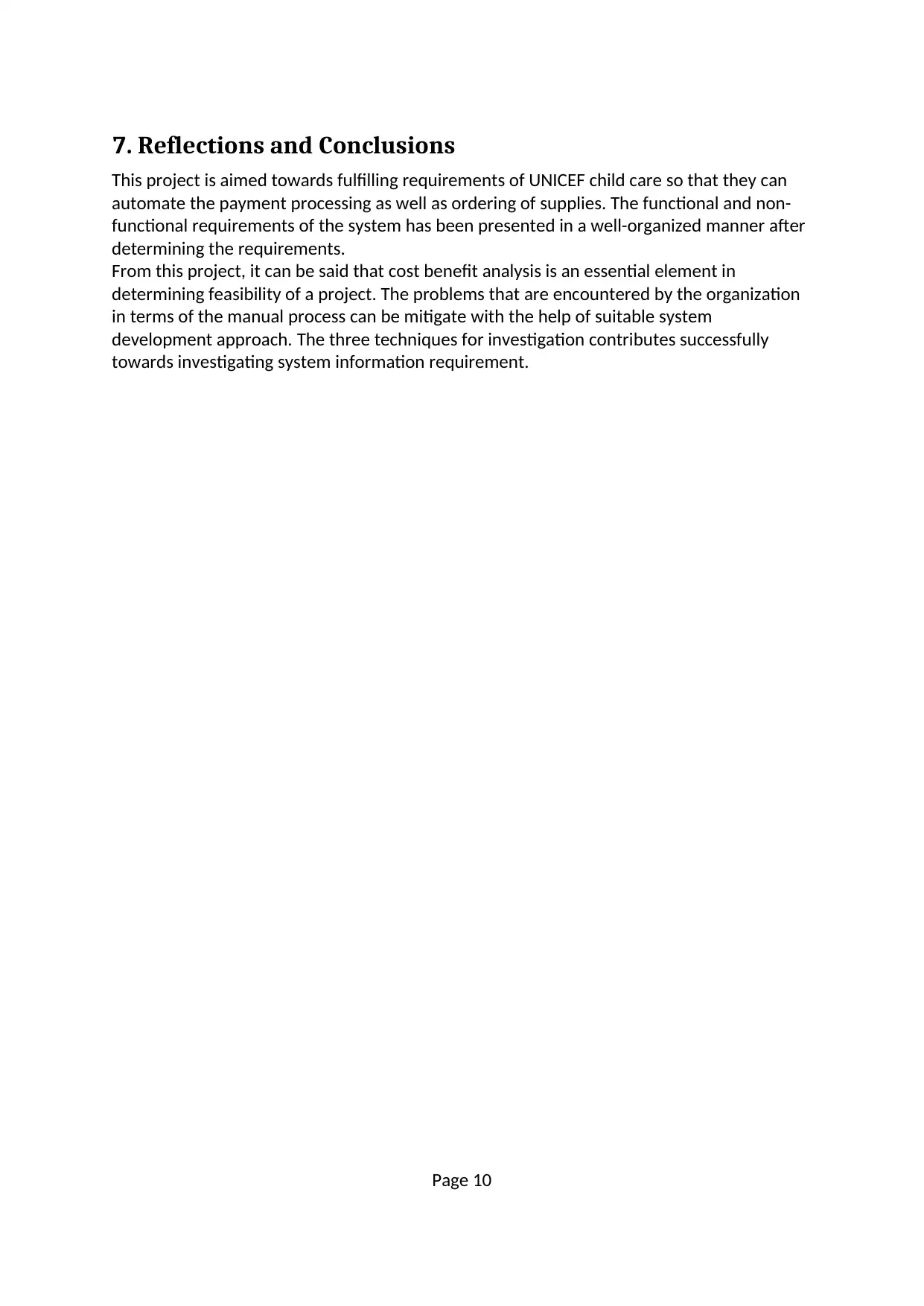
7. Reflections and Conclusions
This project is aimed towards fulfilling requirements of UNICEF child care so that they can
automate the payment processing as well as ordering of supplies. The functional and non-
functional requirements of the system has been presented in a well-organized manner after
determining the requirements.
From this project, it can be said that cost benefit analysis is an essential element in
determining feasibility of a project. The problems that are encountered by the organization
in terms of the manual process can be mitigate with the help of suitable system
development approach. The three techniques for investigation contributes successfully
towards investigating system information requirement.
Page 10
This project is aimed towards fulfilling requirements of UNICEF child care so that they can
automate the payment processing as well as ordering of supplies. The functional and non-
functional requirements of the system has been presented in a well-organized manner after
determining the requirements.
From this project, it can be said that cost benefit analysis is an essential element in
determining feasibility of a project. The problems that are encountered by the organization
in terms of the manual process can be mitigate with the help of suitable system
development approach. The three techniques for investigation contributes successfully
towards investigating system information requirement.
Page 10
⊘ This is a preview!⊘
Do you want full access?
Subscribe today to unlock all pages.

Trusted by 1+ million students worldwide
1 out of 13
Related Documents
Your All-in-One AI-Powered Toolkit for Academic Success.
+13062052269
info@desklib.com
Available 24*7 on WhatsApp / Email
![[object Object]](/_next/static/media/star-bottom.7253800d.svg)
Unlock your academic potential
Copyright © 2020–2025 A2Z Services. All Rights Reserved. Developed and managed by ZUCOL.



